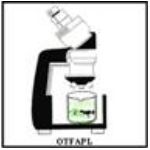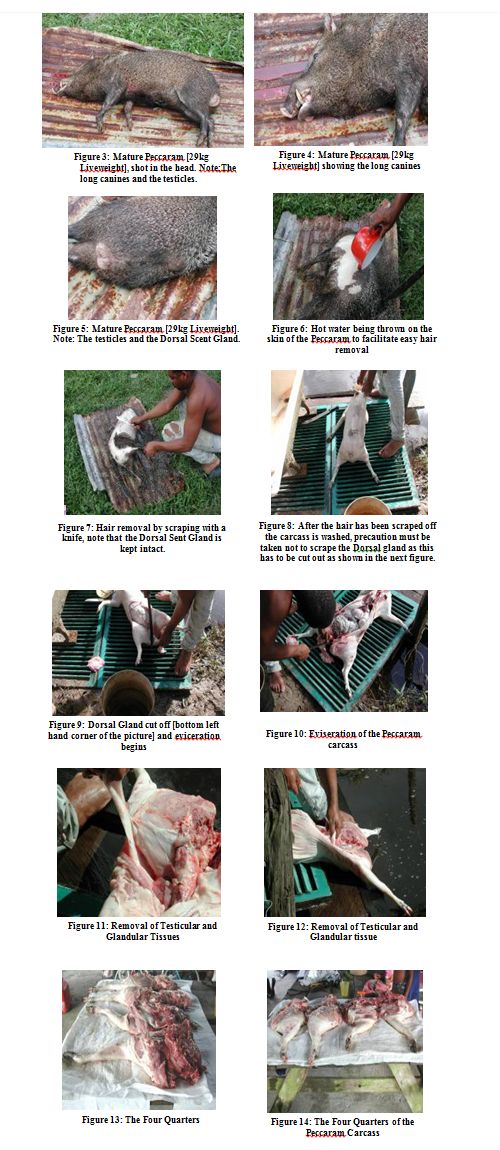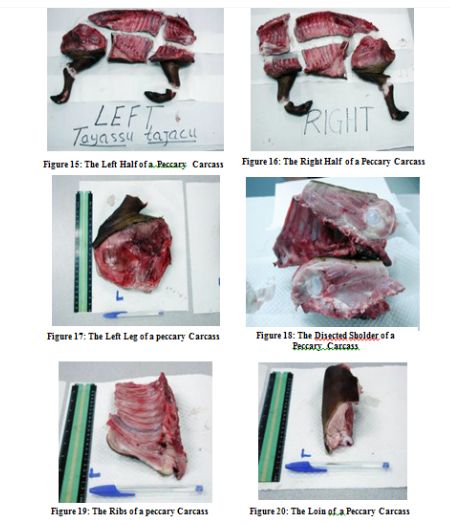
AGLS 2004 - Livestock Products Technology
This section has been written to explain to you how the Peccary is transformed from being on the hoof [alive] to meat suitable for human consumption.
3.1.9.1 Peccary Slaughter and Dressing
When the animal is hunted it is usually shot in the head. However, in an intensive farming situation it is best to restrain the animal and stun it using a “captive bold piston gun”.
A soon as the animal goes down it is best to cut its jugular and then bleed the animal (exsanguinations). Figure 3.1.9.1a describes the process flow for generalized animal slaughter. After exsanguinations what is done next will be based on if you are going to skin the animal for the skin to be preserved for later use or if you are going to use it for meat with the skin intact.
There are two approaches in extracting the meat from the animal as follows:
1. Skinning the animal first: or
2. Not Skinning the animal, and this would involve:
(i) Burning off the hair, or
(ii) Scraping off the hair using boiling water.
General practices for either approach:
The very first word of caution is “do not allow the knife to cut the external part of the dorsal scent gland”.
If the animal is going to be skinned to preserve the skin the dorsal scent gland comes off with the skin.
If the animal is going to be used for meat with the skin intact, then the dorsal scent gland must be carefully cut off as shown in Figures below.
The standard techniques used for slaughtering small ruminants are applicable to the Peccary but with the caution as stated above. Figure 3.1.9.1a presents the generalized slaughter process as earlier stated.
1. Skinning the Animal
1. Start with the Peccary on its back.
2. Make cuts from the inside of the legs from below the knee to the belly incision. You should skin out the hind quarters by cutting around the hock and peeling the hide back.
3. Remember do not cut into dorsal the scent glad, it will peel off with the hide.
4. Hang the Peccary from the hind legs and pull the hide down, using your knife as required, to the base of the skull.
5. Make a circular cut around the neck to the bone at the base of the skull.
6. Hold the skull stationary, while turning the body and the body would separate from the skull.
7. Once the skinning is finished, split the chest, remove any remaining viscera in the upper rib cage and neck area.
8. Remove any hair and debris by washing with clean cool water.
9. Cover carcass and hang.
Figure 3.1.9.1a presents the process for Peccary slaughter.

2. Not skinning the animal
1. If the hair is going to be burned - hold the animal over a fire and slowly roast off the hair, then scrape and follow the procedure as described below.
2. If the hair is going to be scraped off with boiling water then follow the steps as shown in Figures 3.9.1.1a.
3. Place the Peccary on its back.
4. Starting at the anus, cut through the skin around the anus (and sows genitals as applicable).
5. Pull colon free far enough to tie off with string. Normally, at this point you will need to clean fecal matter which was "produced" during this step. Be sure to clean knife and area thoroughly with water to prevent contamination with meat during remainder of the dressing process.
6. Next slit the abdomen using your fingers to guide the knife and keep the blade away from the stomach and intestines. Remember keep the knife at a low angle and cut only deep enough to slice through the skin.
7. You can split the rib cage next.
8. The diaphragm separates the chest and body cavities and must be cut away.
9. Reach inside the chest cavity and loosen the heart, liver, and lungs from connective tissues. Use a plastic bag to put the heart and liver in.
10. Roll the carcass on its side so you can remove the entrails. Most of the entrails will pull away easily. Carefully cut and loosen any connective tissues-Pay attention NOT to puncture the bladder.
11. Ensure the colon and anus which were tied with string pull back through the pelvic channel.
back to top
3.1.9.2 Carcass Evaluation of an Old Male Peccary
The carcass data on the male slaughtered in French Guiana is presented below.
Estimated Age >10 Years;
Estimated Live Weight = 29.47 kg.
DRESSING PERCENTAGE = (21.79/29.47) x 100/1 = 73.9 %
Subsequent to this in Trinidad and Tobago we were able to describe different cuts for the peccary carcass along those already known for the Domestic Pig.
back to top
3.1.9.3 Fabrication of a Peccary Carcass
Animal carcass fabrication is defined as the cutting up of the carcass into its component parts for culinary purposes. This is necessary for the following reasons:
1. in order to obtain the maximum added value from each cut of meat;
2. to be able to have cuts of meat suited to specific or specialized dishes;
3. to be able to get the highest price possible for the higher valued cuts;
4. to be able to make the best possible use of the carcass.
back to top
(yellowdiv)
Lecture Slides 3.1.9 - The Conversion of Peccary Animal to Meat
Lecture Slides
-
-
- 1.1.1 Overview of Livestock Production Systems in CARICOM region
- 1.1.2 Importance of ruminants to our economies and to mankind
- 1.1.3 Non-Ruminant Livestock Production
- 1.1.4 The linkage between the production of food from livestock and crop
- 1.1.5 Factors Affecting Livestock Production
- 1.1.6 Types of Livestock Production Systems
-
- 1.2.1 The Tropics Defined
- 1.2.2 The Diversity of the Tropical Environment
- 1.2.3 Climatic factors of prime importance to agriculture and animal production in the Tropics
- 1.2.4 Physical factors of prime importance to agriculture and animal production in the Tropics
- 1.2.5 Some socio-economic considerations of relevance to the Tropics
- 1.2.6 Animal Production in the Tropics: Status and Horizons
- 1.2.7 Features of Tropical Livestock Commodities
-
In this section, we cover:
3.1.9.1 Peccary Slaughter and Dressing - 2 approaches would be described: skinning the animal first, and not skinning the animal
3.1.9.2 Carcass Evaluation of an Old Male Peccary - carcass data on the male slaughtered in French Guiana
3.1.9.3 Fabrication of a Peccary Carcass - cutting up of the carcass into its component parts for culinary purposes
3.1.9.1 Peccary Slaughter and Dressing - 2 approaches would be described: skinning the animal first, and not skinning the animal
3.1.9.2 Carcass Evaluation of an Old Male Peccary - carcass data on the male slaughtered in French Guiana
3.1.9.3 Fabrication of a Peccary Carcass - cutting up of the carcass into its component parts for culinary purposes
This section has been written to explain to you how the Peccary is transformed from being on the hoof [alive] to meat suitable for human consumption.
3.1.9.1 Peccary Slaughter and Dressing
When the animal is hunted it is usually shot in the head. However, in an intensive farming situation it is best to restrain the animal and stun it using a “captive bold piston gun”.
A soon as the animal goes down it is best to cut its jugular and then bleed the animal (exsanguinations). Figure 3.1.9.1a describes the process flow for generalized animal slaughter. After exsanguinations what is done next will be based on if you are going to skin the animal for the skin to be preserved for later use or if you are going to use it for meat with the skin intact.
There are two approaches in extracting the meat from the animal as follows:
1. Skinning the animal first: or
2. Not Skinning the animal, and this would involve:
(i) Burning off the hair, or
(ii) Scraping off the hair using boiling water.
General practices for either approach:
The very first word of caution is “do not allow the knife to cut the external part of the dorsal scent gland”.
If the animal is going to be skinned to preserve the skin the dorsal scent gland comes off with the skin.
If the animal is going to be used for meat with the skin intact, then the dorsal scent gland must be carefully cut off as shown in Figures below.
The standard techniques used for slaughtering small ruminants are applicable to the Peccary but with the caution as stated above. Figure 3.1.9.1a presents the generalized slaughter process as earlier stated.
1. Skinning the Animal
1. Start with the Peccary on its back.
2. Make cuts from the inside of the legs from below the knee to the belly incision. You should skin out the hind quarters by cutting around the hock and peeling the hide back.
3. Remember do not cut into dorsal the scent glad, it will peel off with the hide.
4. Hang the Peccary from the hind legs and pull the hide down, using your knife as required, to the base of the skull.
5. Make a circular cut around the neck to the bone at the base of the skull.
6. Hold the skull stationary, while turning the body and the body would separate from the skull.
7. Once the skinning is finished, split the chest, remove any remaining viscera in the upper rib cage and neck area.
8. Remove any hair and debris by washing with clean cool water.
9. Cover carcass and hang.
Figure 3.1.9.1a presents the process for Peccary slaughter.

2. Not skinning the animal
1. If the hair is going to be burned - hold the animal over a fire and slowly roast off the hair, then scrape and follow the procedure as described below.
2. If the hair is going to be scraped off with boiling water then follow the steps as shown in Figures 3.9.1.1a.
3. Place the Peccary on its back.
4. Starting at the anus, cut through the skin around the anus (and sows genitals as applicable).
5. Pull colon free far enough to tie off with string. Normally, at this point you will need to clean fecal matter which was "produced" during this step. Be sure to clean knife and area thoroughly with water to prevent contamination with meat during remainder of the dressing process.
6. Next slit the abdomen using your fingers to guide the knife and keep the blade away from the stomach and intestines. Remember keep the knife at a low angle and cut only deep enough to slice through the skin.
7. You can split the rib cage next.
8. The diaphragm separates the chest and body cavities and must be cut away.
9. Reach inside the chest cavity and loosen the heart, liver, and lungs from connective tissues. Use a plastic bag to put the heart and liver in.
10. Roll the carcass on its side so you can remove the entrails. Most of the entrails will pull away easily. Carefully cut and loosen any connective tissues-Pay attention NOT to puncture the bladder.
11. Ensure the colon and anus which were tied with string pull back through the pelvic channel.
back to top
3.1.9.2 Carcass Evaluation of an Old Male Peccary
The carcass data on the male slaughtered in French Guiana is presented below.
Estimated Age >10 Years;
Estimated Live Weight = 29.47 kg.
| Carcass Component | Weight (kg) | % Live Weight | % Carcass |
| Head | 3.07 | 10.25 | |
| Liver, Heart, Lungs | 0.91 | 3.10 | |
| Stomach & Intestines | 2.90 | 9.68 | |
| Front Leg (left) | 4.25 | 14.19 | 19.0 |
| Ribs | 2.27 | 7.58 | 12.4 |
| Front Leg (right) | 4.10 | 13.69 | 18.4 |
| Ribs | 2.53 | 8.45 | 11.4 |
| Hind Leg & Foot (L) | 4.45 | 14.86 | 20.0 |
| Hind Leg & Foot (R) | 4.19 | 13.99 | 18.8 |
| Hind Gland | 0.16 | 0.53 | |
| Blood | 0.64 | 2.13 | |
| TOTAL | 29.95 | 98.45 | 100.0 |
DRESSING PERCENTAGE = (21.79/29.47) x 100/1 = 73.9 %
Subsequent to this in Trinidad and Tobago we were able to describe different cuts for the peccary carcass along those already known for the Domestic Pig.
back to top
3.1.9.3 Fabrication of a Peccary Carcass
Animal carcass fabrication is defined as the cutting up of the carcass into its component parts for culinary purposes. This is necessary for the following reasons:
1. in order to obtain the maximum added value from each cut of meat;
2. to be able to have cuts of meat suited to specific or specialized dishes;
3. to be able to get the highest price possible for the higher valued cuts;
4. to be able to make the best possible use of the carcass.
Figure 3.1.9.3a Fabrication of a Peccary
Carcass


| English | French | Spanish | Portuguese | Dutch | % Carcass Weight |
| Head | Tête | Cabeza | Cabeca | ||
|
Loin Chop / Tenderloin |
Cadre & Filet |
Lomo/ Filete/ Solomillo |
Lombo | 18 % | |
| Belly |
Plait de Cotes & Poitrine |
Barriga/ vientre | Barriga, bojo | 8 % | |
| Blade Bone | Palette | Paletilla | Paleta |
34 % includes Blade Bone and Spare ribs |
|
| Spare Ribs | Echine | Costillas | Costela | ||
| Hand, Hock and Knuckle | Jambonneau & Pied | Mano y pieds | 6 % | ||
| Leg | Jambon/ Jambe | Pierna | Perna | 34 % |
back to top